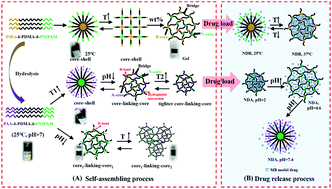A thermo-/pH-responsive hydrogel (PNIPAM-PDMA-PAA) with diverse nanostructures and gel behaviors as a general drug carrier for drug release†
Abstract
The aim of this research was to develop thermo- and pH-responsive hydrogels based on H-bonds for the sustained release of the small-molecule model drug Methylene Blue (MB). The thermo- or pH-sensitive triblock copolymer based on PNIPAM or PAA was synthesized by sequential RAFT polymerization and hydrolysis. By tuning the temperature or pH, the copolymer was able to form diverse nanostructures, including core–shell micelles, electronegative or uncharged core–shell structures and 3D networks with the hydrophobic forces of PNIPAM or H-bonds between PAA and PNIPAM. Furthermore, the reversible sol–gel transition of the copolymers was modulated by temperature (∼37 °C), pH (∼5) and concentration (∼7 wt%). The drug release potential was evaluated via in vitro injection of copolymer hydrogels into a simulated human body device. The copolymer hydrogels exhibited a sustained drug release behavior and a low instantaneous drug concentration. The MTT studies revealed that there is no noticeable cytotoxicity of NDB or NDA hydrogels against cells. Thus, the tunable drug release efficiency suggests the possibility of PNIPAM- and PAA-based environment responsive hydrogels being applied as drug carrier systems.



 Please wait while we load your content...
Please wait while we load your content...